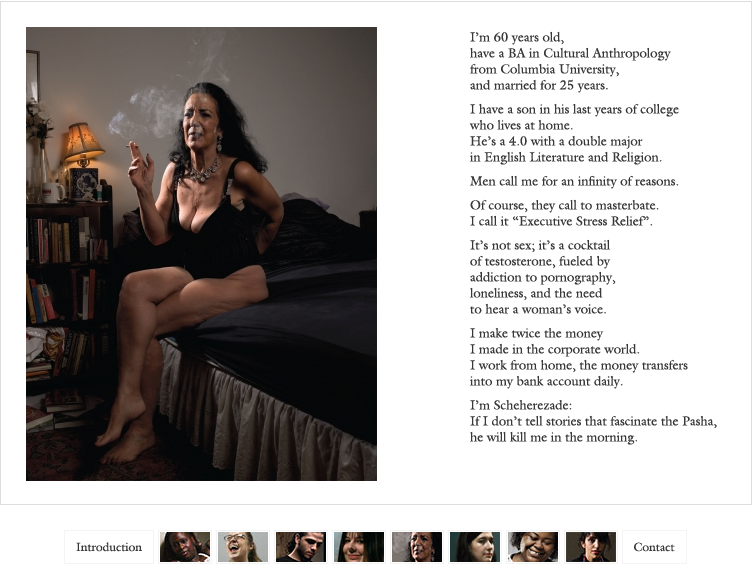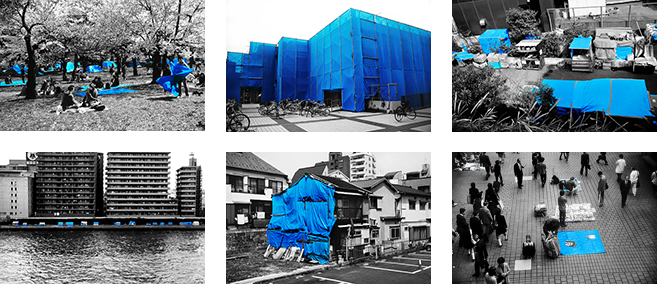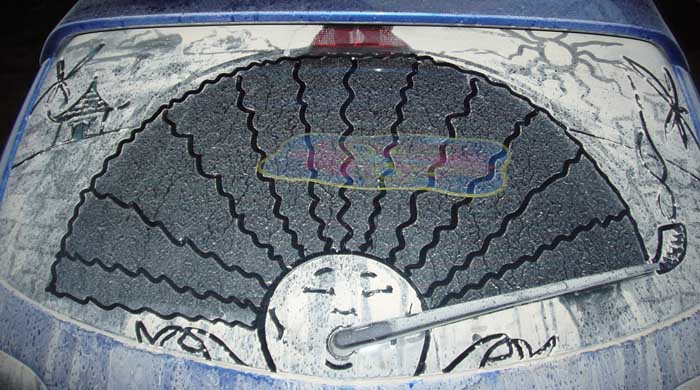The park bench, last refuge of peace and quiet in the city, becomes a billboard. Triangular slats rotate to deliver the message: “Peace & Quiet, AVAILABLE”. With thanks to Parvalux Electric Motors and Trench Control Ltd for equipment and technical support.
Support for Detained Iranian Student
To show their support for a detained Iranian student leader, who was photographed in women’s clothes he may have been forced to wear, these men posted photographs of themselves wearing similar clothes on the Web.
On Wednesday, The Lede looked at the response from Iranian bloggers and human rights activists to the treatment of Majid Tavakoli, a student leader who was detained after Monday’s demonstrations in Tehran, and subsequently mocked by official Iranian news agencies that published photographs of him wearing female clothes taken after his arrest.
Supporters of Iran’s opposition suspect that the photographs of Mr. Tavakoli were either faked or staged by the security forces to embarrass him. Writing on Twitter on Thursday, Omid Habibinia, an Iranian journalist who micro-blogs from Switzerland, reported that some male Facebook users have found a new way to express their support for Mr. Tavakoli — by changing their profile pictures to show them wearing similar clothes.
In a post on the Web site of Radio Free Europe/Radio Liberty — which is supported by the American government — Golnaz Esfandiari provided links to a collection of these photographs on another blog and to a Facebook page set up to “support of Majid Tavakoli” and also condemn “forced hijab in Iran.” According to the Iranian blogger Mojtaba Samienejad, the stunt of releasing these photographs may have backfired, by reminding male supporters of Iran’s opposition of the way that women in Iran are coerced into dressing a certain way.
http://thelede.blogs.nytimes.com/2009/12/10/more-support-for-detained-iranian-student/
Phone Sex - Book
Phillip Toledano has photographed nearly thirty phonesex operators in the intimate setting of their own homes, offering a seldom-seen glimpse into the reality of what otherwise is a fantasy created by the operator’s voice, and caller’s imagination. Accompanying every portrait is a text written by each subject touching on some aspect of his or her experience as an operator. Whether touching, humorous, or disturbing, every operator’s point of view is compelling. - Amazon Product Description
C’ÉTAIT UN RENDEZ-VOUS
On an August morning in 1976, French filmmaker Claude Lelouch mounted a gyro-stabilized camera to the bumper of a Ferrari 275 GTB and had a friend, a professional Formula 1 racer, drive at breakneck speed through the heart of Paris. No streets were closed, for Lelouch was unable to obtain a permit.
Food Inc.
You’ll never look at dinner the same way again
It takes a little long to load but it’s worth the wait
Tokyo Blues
Everywhere you go, there are certain things which play heroic roles in knitting the world together, and which somehow remain anonymous, even unseen. Our first book, Tokyo Blues, is the story of one of them: the common blue PVC plastic construction tarp.
Now available for purchase or free download, Tokyo Blues is a photographic record of Nurri Kim’s 2002-2003 investigation into this humble industrial material and the very wide variety of uses to which it’s put in the everyday life of Japan.
From construction sites and homeless settlements to cherry-blossom viewing parties in the park, the ubiquitous blue tarp is a constant of Japanese life and a bearer of multiple registers of meaning. In sixty-four images from the boulevards, alleys, sidestreets and interstitial spaces, Tokyo Blues explores these dramatically different contexts, returning something “we see too often, and then forget to see” to full, vivid visibility. The result is a book that provokes its readers to see the city around them with new eyes — whether that city is Tokyo, or their own.
Every Person In New York

I am trying to draw every person in New York. I will be drawing people everyday and posting as frequently as I can. It is possible that I will draw you without you knowing it. I draw in Subway stations and museums and restaurants and on street corners. I try not to be in the way when I am drawing or be too noticeable. Whenever I have a new batch of drawings I will post them on this blog. If you would like to increase the chances of a portrait of YOU appearing on this blog please email me (art@jasonpolan.com) a street corner or other public place that you will be standing at for a duration of two minutes (I will be on the corner of 14th street and 8th avenue on the North-east corner of the street from 2:42-2:44pm this Thursday wearing a bright yellow jacket and navy rubber boots, for example). Please give me more than a 24 hour warning and please make it a scenario that is not too difficult for you to accomplish (the corner outside of the store you work at during lunch time, or in front of a museum you were going to go to on a Saturday) because I may unfortunately miss you and do not want you to have to invest more than 2 minutes of your time in case I cannot make it. You may or may not see me drawing you during this time. If I do draw you, you will see yourself (or rather, a drawing that hopefully somewhat resembles you) on this blog that evening.
When the project is completed we will all have a get together.
Give the Gift of Giving, Without Really Giving
IN A.D. 2009 WAR WAS BEGINNING ON THE INTERWEBZ.
Gap: Sprize
A Gap store gets flipped upside down in a promotion for the brand’s new Sprize loyalty program.
Haibao’s gender finally revealed
Sad Panda revealed
Since around March this year, a sad-looking panda has been spotted roaming the streets of New York City — on the subway, in Times Square, at various parks and around Wall Street’s bull statue. Over the next few months, the Sad Panda has intrigued and fascinated New Yorkers — his short disappearance on Wall Street led a few concerned individuals to put up a missing notice, and his great makeover as Spongebob Squarepants did not go unnoticed. Turns out this Sad Panda is a 62 year old man from Guangzhou, Chen Jialing, who has now lived in the United States for many years. He confides in journalism student Michelle Tay the story of how he became Sad Panda after being forced to leave his former restaurant job. Read all about Sad Panda on Gothamist here, here, here, here, here, here and here
via http://shanghaiist.com/2009/11/19/nyc-sad-panda-guangzhou.php
Converse: Let’s Play
Everything You Need to Know (and Do) as You Pursue Your Art Career
The most comprehensive guide of its kind, Art/Work gives artists of every level the tools they need to make it in an art world so competitive one dealer likens it to “The Sopranos, except nobody gets killed.” Whether you’re an art school grad looking for a gallery, a mid-career artist managing a busy studio, or someone just thinking about becoming a professional artist, this indispensable resource will help you build your career and protect yourself along the way.
Unlike other creative professionals, visual artists don’t have agents or managers. You have to do it all yourself, at least until you find gallery representation — and even then, there are important business and legal issues you need to understand to stay in control of your career and ensure you’re being treated fairly. Heather Darcy Bhandari, a gallery director, and Jonathan Melber, an arts lawyer, walk you through these issues so that you can essentially act as your own manager and agent. They show you, for example, how to tackle business basics such as tracking inventory and preparing invoices; how to take legal precautions like registering a copyright and drafting consignment forms; how to use promotional tools like websites and business cards; and how to approach career decisions such as choosing the right venue to show your work.
In addition to drawing on their own experiences, Bhandari and Melber interviewed nearly one hundred curators, dealers, and other arts professionals, in cities across the country, about what they expect from and look for in artists. The authors also talked to a host of artists about their careers and the lessons they’ve learned navigating the art world. The book is full of their entertaining anecdotes and candid advice.
No matter what kind of artist you are — or want to be — this book will help you. Art/Work covers everything you need to know to succeed, saving you from having to learn it all the hard way — and letting you spend more time making art.
I came
High Five New York City
Guy goes around NYC on a bike high-fiving people who are waving for taxis.
People of Walmart
Copyright © _dreams. All rights reserved.










